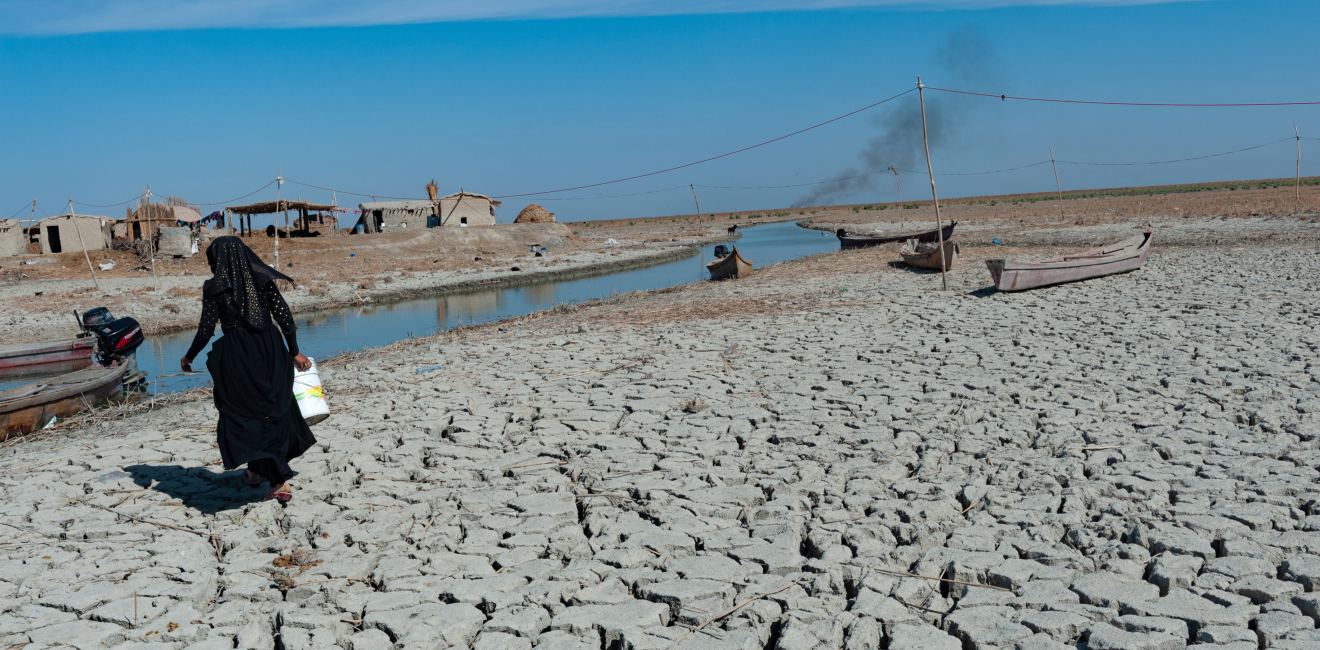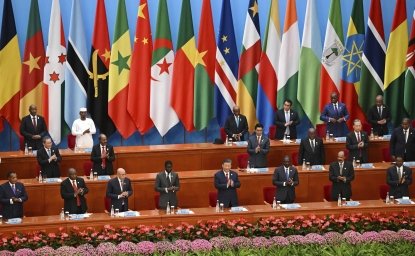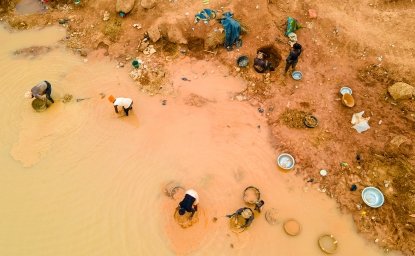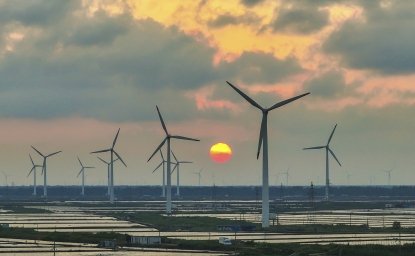Groundwater Depletion in the West Bank
By Khalil Abu Allan
High temperatures and excessive precipitation rates may threaten the quality of drinking water, given the limited treatment facilities.
Climate change will affect most sectors of the economy in the Palestinian territories, especially the water sector, which will be most impacted in terms of water availability and quality. Freshwater resources - surface and groundwater - will become more scarce due to decreasing precipitation rates. This will make it more difficult to replace groundwater during periods of high population growth, coinciding with the intensification of competition for water between the Palestinian agriculture industry, Israeli settlements, and the industrial sector.
Less rainfall will also increase the cost and amount of energy needed to extract water. In addition, high temperatures and excessive precipitation rates may threaten the quality of drinking water, given the limited treatment facilities. Measurements of groundwater levels through a geological survey of some areas of the West Bank have observed that 45 percent of the sub-aquifers have decreased sharply and significantly, and this has led to the desiccation of 15 percent of the soils in the areas surrounding the decreasing aquifers.
This exacerbates the water demand crisis, which will have direct effects on the topology of the food network, which constitutes an important resource that supports the Palestinian economy, in addition to the fact that the West Bank is already suffering from a major water crisis. Climate change predictions for Palestine territories from high-resolution regional climate models show above-average global warming over this century in the range of 2.12-4.9°C (35.8-40.82°F) according to a realistic emissions scenario.
The impact of climate change on groundwater in the West Bank and the decrease in its quantities has led to a significant increase in the prices of agricultural products, especially from agriculture that relies extensively on irrigation; 7 percent of farmers have left their lands due to the high cost of obtaining water.
Financing Climate Action in Egypt
By Eslam A. Hassanein
The lack of adequate financial resources remains Egypt's main obstacle to responding to climate hazards.
Building climate-resilience while coping with near-term crises is crucial, but neither can be achieved without adequate finance. Unfortunately, climate finance is not keeping up with climate change's escalating impacts. Egypt is among the most susceptible countries to climate change due to its growing population concentrated in the densely populated Nile Delta. Egypt's carbon emissions increased by 155 percent between 1990 and 2018, three times more than the global rate of 50 percent. Additionally, climate change is projected to cost Egypt between 2 and 6 percent of its GDP by 2060.
In response, the Egyptian government has developed a coherent policy agenda for climate action that is institutionally ahead of many of its MENA peers. The country has made significant strides in climate change mitigation and adaptation strategies, such as doubling its wind energy production, constructing desalination plants and flood control infrastructure, and launching the first green sovereign bond in the MENA region, worth $750 million and offering a 5.25 percent yield. The country pledged to cut emissions 25 percent by 2030 in its revised Nationally Determined Contribution (NDC), which also encompasses various adaptation and mitigation projects. Yet, for these projects to be completed by 2030, $50 billion in financing is required.
Unfortunately, the Egyptian pound suffered a half-value decline last year, making it the worst-performing currency in 2023. Even though the country receives the most significant proportion of climate finance in the MENA region (28 percent), the region hosts the least amount of climate finance globally, estimated at $16 billion annually, with financing needs approximated at $186 billion based on countries’ NDCs.
Deferring climate finance investment is not an option. The lack of adequate financial resources remains Egypt's main obstacle to responding to climate hazards. Collaboration with the private sector, foreign direct investment, and international cooperation will open doors to alternative financial resources for the country's green transition.
Decreasing Snowpack and Rainfall in Turkey
By Gokce Sencan
These impacts jeopardize everyone’s welfare in Turkey by endangering food, water, and energy security, as well as posing public health threats and harming Turkey’s precious ecosystems.
The most urgent climate-related challenge facing Turkey is elevated drought risk. As part of the Mediterranean Basin, a climate hot spot, Turkey will experience the consequences of climate change earlier and harsher than many other parts of the world, including more severe and prolonged droughts. These drought events typically occur concurrently with three trends: (1) a shrinking snowpack, hence reduced flows in Turkey’s rivers, (2) higher average temperatures, which also escalate extreme heat risk and (3) less rainfall in southern regions, resulting in a drier climate and aridification.
These droughts can be debilitating for Turkey in several ways. In times of drought, crops need more watering due to less rainfall and hotter weather. Furthermore, elevated extreme heat risk threatens crop health, leading to reduced crop yield at best and complete crop loss at worst. More intense droughts mean more severe wildfires, particularly in the Mediterranean region. Forest vegetation dries up and becomes more flammable due to hotter weather and inadequate rainfall.
Many cities in Turkey are vulnerable since they mainly rely on captured rainfall and river flows to supply water for their residents. During droughts, cities have less water and their ability to provide water for human consumption is imperiled. Turkey depends heavily on hydropower to meet the country’s electricity demand. But during droughts, hydropower output can decrease dramatically as the water levels in reservoirs drop. This results in more reliance on imported fossil fuels like coal and natural gas to compensate for the loss.
These impacts jeopardize everyone’s welfare in Turkey by endangering food, water, and energy security, as well as posing public health threats and harming Turkey’s precious ecosystems. Investing in water conservation and wastewater recycling, boosting funding for maintaining forest health, and implementing tighter groundwater management regulations could be good starting points.
Extreme Temperatures Add Up in Warming Gulf Countries
By Neeshad Shafi
When extreme weather and temperature are combined, the consequences are multiplied several fold – making populations in the Arab region more vulnerable.
The Middle East and the Arab region are already facing rising temperatures almost twice as quickly as the rest of the world, according to a report by The Cyprus Institute’s Climate and Atmosphere Research Center and the Max Planck Institute for Chemistry. The temperature during summer is already very hot in MENA and will increase more than two times faster than the global average, making it one of the most vulnerable regions in the world to the disastrous consequences of climate change.
In recent years we have started to see the extreme weather impacts in a much more visible way, adding to the existing temperature rise. According to the study, what makes the Arab region more susceptible to higher increases in temperatures than some other parts of the world are geographical features such as large expanses of desert and lower ground water levels. Extreme weather conditions like the deadly flash floods in Fujairah in the UAE, flooding in Qatar, and flash flood in Oman are examples of the impacts affecting the Gulf region.
When extreme weather and temperature are combined, the consequences are multiplied several fold – making populations in the Arab region more vulnerable. In these challenging times, it is crucial for the world to come together and address the threat of climate change and help countries in the Arab Middle East to adapt. Regardless of the climate change scenario in the latest IPCC AR6 synthesis report, it will become reality soon or later: climate change will result in a significant deterioration of living conditions for people in the Arab Middle East countries, and consequently, many people may have to leave the region due to rising temperatures.
The views expressed in these articles are those of the author and do not reflect an official position of the Wilson Center.









